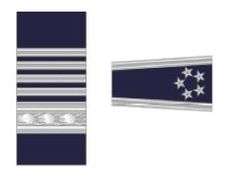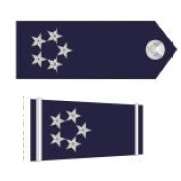General of the Air Force
The General of the Air Force (abbreviated as GAF[1]) is a five-star general officer rank and is the highest possible rank in the United States Air Force. General of the Air Force ranks immediately above a general and is equivalent to General of the Army in the United States Army and Fleet Admiral in the United States Navy. The rank has been held only once in history, by General Henry H. Arnold, who served as head of the United States Army Air Forces during World War II.
| General of the Air Force | |
|---|---|
 General of the Air Force insignia | |
 Rank flag of a General of the Air Force. | |
| Country | |
| Service branch | |
| Abbreviation | GAF |
| Rank | Five-star |
| NATO rank | OF-10 |
| Non-NATO rank | Five-star rank |
| Formation | December 21, 1944 |
| Next lower rank | General |
| Equivalent ranks | |
History
Army Air Forces
The term "General of the Air Force" was first informally used in 1944 after General Henry H. Arnold was promoted, along with other senior World War II American officers, to the rank of General of the Army. Arnold was at that time head of the United States Army Air Forces which had become its own branch of service in all but name. To differentiate Arnold from the other five-star generals in the regular U.S. Army (such as Dwight Eisenhower and Douglas MacArthur), Arnold was commonly referred to as "General of the Air Force Arnold" in all but official correspondence. In official documents, his rank was listed as "General of the Army (USAAF)".
Post-War

On September 18, 1947, the United States Air Force was founded as a separate branch of service. For the first few months of its existence, U.S. Air Force ranks were identical to the Army, and Air Force service members continued to wear the olive drab U.S. Army Air Force uniforms. In early 1948, the Air Force slightly changed some of the rank titles to include codifying Air Force warrant officer positions as well as specifying that the five-star general rank within the Air Force would be known thereafter as "General of the Air Force".[2] On 7 May 1949, under Public Law 58 of the 81st Congress, Henry Arnold's official U.S. Air Force rank was changed from General of the Army to General of the Air Force.
In 1949 the first Air Force blue uniforms were introduced, although regulations allowed former Army Air Force personnel to continue wearing brown uniforms complete with Army badges and insignia (full adoption of the new Air Force uniform would not occur until 1952). Although a "General of the Air Force" insignia was created for the blue jacket, General Arnold was at the time living in retirement in California, and in somewhat poor health, and as such the five-star Air Force rank was never actually worn on active duty by Arnold. Public Law 333 of the 79th Congress had previously changed the five-star rank to a permanent grade, and established that officers placed on the retirement list while in that grade would receive full pay and allowances (under Public Law 282 first establishing this grade, retirement had been at 75 per centum), meaning that Arnold did receive full pay as a General of the Air Force for the rest of his life.
Modern usage

General of the Air Force Arnold died in 1950 with no further Air Force officer since promoted to General of the Air Force. In 1962, during the Cold War, a petition was raised with the Department of the Air Force to promote General Curtis LeMay to the rank of General of the Air Force due to LeMay's accomplishments with the rise of the Strategic Air Command. The Air Force officially responded to the LeMay promotion proposal in a Chief of the Air Force General Officers Branch letter dated February 28, 1962:
It is clear that a grateful nation, recognizing the tremendous contributions of the key military and naval leaders in World War II, created these supreme grades as an attempt to accord to these leaders the prestige, the clear-cut leadership, and the emolument of office befitting their service to their country in war. It is the conviction of the Department of the Air Force that this recognition was and is appropriate. Moreover, appointments to this grade during periods other than war would carry the unavoidable connotation of downgrading of those officers so honored in World War II.

In 1993, General Merrill McPeak introduced an extremely unpopular uniform design which changed Air Force officer insignia to a stripe-based system reminiscent of the United States Navy and often derogatorily referred to as an airline-pilot uniform. During the single year in which this uniform was official, a five-star insignia was designed which appeared on insignia charts. The insignia included both a sleeve-strip design as well as dress shoulder boards for the General of the Air Force rank. This insignia, along with the entire uniform design itself, was discontinued in 1994. A shoulder-board design for the Air Force dress shirt and sweater was also published.[3]
The Air Force currently declares that General of the Air Force is an active rank and it could again be bestowed at the discretion of the United States Congress. However, the President, with consent from the Senate, may award a fifth star at any time he sees fit.[4][5][6]
In the 1990s, there were proposals in Department of Defense academic circles to bestow a five-star rank on the office of the Chairman of the Joint Chiefs of Staff.[7][8][9]
As recently as the late 2000s, some commentators proposed that the military leader in the Global War on Terrorism be promoted to a five-star rank.[10]
Ranks senior to General of the Air Force

The only United States Armed Forces ranks senior to General of the Air Force are General of the Armies and Admiral of the Navy. The General of the Armies rank has been held only twice in United States history, both times by United States Army officers (John J. Pershing and George Washington, respectively) and then only once on active duty (Pershing). No Air Force officer has ever been promoted to a six-star position, although Congress retains the right to do so.
When Omar Bradley died in 1981, Congress sent a letter to the United States Army Institute of Heraldry requesting to know the feasibility of promoting Bradley to the rank of six-star general,[11] as well as requesting clarification as to the procedure should a United States Navy or Air Force officer ever be promoted to six-star rank. The response to Congress stated: "Should an officer of the Air Force or Navy be promoted to six star rank, that officer should be entitled to the six star insignia with a service specific crest".[12]
The Institute of Heraldry designed a sketch depicting the six-star rank utilized in the three major armed force branches; color images were later produced including a design for a six-star Air Force general rank. This insignia has never been declared official by the United States Air Force, but the insignia design has been retained by the awards and decorations branch of Randolph Air Force Base.
See also
- List of United States four-star officers
- List of United States Air Force four-star generals
- List of United States military leaders by rank
- United States Air Force officer rank insignia
References
- Professional Development Guide, Air Force Pamphlet 36-2241 dated 1 July 2009, Randolph AFB, TX
- Department of the Air Force, "Air Force uniform regulations and insignia", 13 February 1948
- Department of the Air Force, "Air Force uniform regulations and insignia", 14 September 1995
- "U.S. Sen. Kasten Pushing Effort To Award Powell With Historic Fifth Star". Jet. 79 (23). March 1991. ISSN 0021-5996. Retrieved 21 February 2011.
...there is a movement afoot in the U.S. Senate to award an historic fifth star to the nation's first Black Joint Chiefs of Staff Chairman Gen. Colin L. Powell for his military proficiency.
- Italia, Bob (1991). Armed Forces: War in the Gulf. Abdo & Daughters. pp. 44–46. ISBN 978-1-56239-026-6. Retrieved 21 February 2011.
- Stephanopoulos, George (1999). All Too Human: A Political Education. Thorndike Press. pp. 330–331. ISBN 978-0-7862-2016-8. Retrieved 21 February 2011.
- Organizing for National Security: The Role of the Joint Chiefs of Staff. Institute for Foreign Analysis. January 1986. p. 11. Retrieved 21 February 2011.
There was some discussion of the proposal to grant the Chairman of the Joint Chiefs five-star rank, as a symbol of his status as the most senior officer in the armed forces.
- Jones, Logan (February 2000). "Toward the Valued Idea of Jointness: The Need for Unity of Command in U.S. Armed Forces" (PDF). Naval War College: 2. ADA378445. Retrieved 21 February 2011. Lay summary.
Promoting the Chairman to the five-star rank and ceding to him operational and administrative control of all U.S. Armed Forces would enable him to provide a unifying vision...
Cite journal requires|journal=(help) - Owsley, Robert Clark (June 1997). "Goldwater-Nichols Almost Got It Right: A Fifth Star for the Chairman" (PDF). Naval War College: 14. ADA328220. Retrieved 21 February 2011. Lay summary.
...Chairman's title be changed to Commander of the Armed Forces and commensurate with the title and authority he be assigned the grade of five stars.
Cite journal requires|journal=(help) - Stringer, Kevin D. (2007). "A Supreme Commander for the War on Terror" (PDF). JFQ. National Defense University Press (44): 23. Archived from the original (PDF) on 22 February 2011. Retrieved 21 February 2011.
The development of a four- or even five- star commander with staff to run the war on terror...
- Congressional Record 1981, Cong. 97 Sess. 1 – Parts 6-8, "Comparison and Promotion Procedures for General of the Armies and General of the Army of the United States".
- Congressional Record 1981, Cong. 97 Sess. 1 – Part 8, "Promotion of other service branches to General of the Armies of the United States".
Sources
- Service record of Henry Arnold, Military Personnel Records Center, St. Louis, Missouri
- Service record of Curtis Lemay, Military Personnel Records Center, St. Louis, Missouri